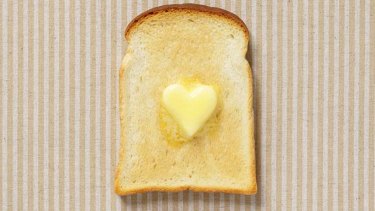What fat you eat is less important than the food in which it is found
Fat, in its various forms, is at the heart of an international debate over what is and is not healthy eating, but are we slipping in butter and missing the point?
The point being that the fat is far less important than the food in which it is found and, if we get the food right, we can handle some fat in whatever form we like: for me, preferably in the form of butter on my sourdough.
Butter: at the heart of the latest dietary guideline debate.
Last Thursday, a group of nutrition experts from around the world released a paper calling for revisions to be made to the new World Health Organisation dietary guidelines draft.
The issue, they wrote in The BMJ, was that the draft recommends limiting our intake of saturated fat foods but ignores the sources of the fat.
Lumped together under the umbrella of “saturated fat” are custard tarts and cheddar cheese, coconut oil and lard, white chocolate and cashews, butter and full-fat yoghurt. Doing this skews the evidence the recommendations are based on, the experts said.
For example, many studies linking saturated fat with cardiovascular disease have isolated the fatty acids from the food matrix (compounds like fibre and minerals in whole foods) they are part of, or used synthetic forms not commonly found in our diets.
“Saturated fatty acids are found in a wide diversity of foods that vary in composition and structure, resulting in different physiological effects,” they wrote.
Public health nutritionist, Rosemary Stanton, who was not involved with the paper, explains: “For example, butter has a different effect on cholesterol levels compared with fermented dairy products such as yoghurt or cheese, even though the foods all contain the same saturated fatty acids (admittedly in different quantities).”
Moreover, the authors wrote, the food matrix “might be more important” for the effect of cardiovascular health than saturated fat.
“We strongly recommend a more food-based translation of how to achieve a healthy diet and reconsideration of the draft guidelines on reduction in total saturated fatty acids,” they said.
The problem is it’s a circular argument, says Professor Amanda Lee, from the School of Public Health at the University of Queensland, because it calls for a food-based focus while bringing the focus back to a single nutrient.
“We either look at diet or we look at nutrients, we need to stop confusing the two,” says Lee, adding the Australian Dietary Guidelines (ADG) are food-based, covering our nutrient bases so that we can sit back and enjoy our food.
Nutrient-based guidelines don't work, adds Stanton:“I do think we should totally abandon nutrient-based guidelines (which are the basis of the Health Star Rating system) and are beloved by the food industry because the 'nutrient' approach leads to health claims on processed foods.”
The ADG does suggest limiting saturated fat, but they single out "biscuits, cakes, pastries, pies, processed meats, commercial burgers and pizza, fried foods, potato chips, crisps and other savoury snacks, butter, cream, coconut and palm oils".
Have a diet that suits you, that isn’t excessive to your energy needs and that has as much variety as possible.
And although they recommend “mostly reduced fat” dairy, it is not because of the saturated fat content. It is because we are mostly sedentary as a nation and full fat has higher energy content, so it was about creating energy limits, explains Lee.
“It created more room in the diet for other healthy foods,” she says. “If you want to have full cream milk, that’s fine – there does seem to be something protective about the matrix of dairy foods.”
The ADG, she adds, with different options in each food group, are designed to be flexible to make it “easier for people to eat well”.
So if we have an optimal diet – that is one mostly based on fresh fruits and vegetables, legumes (e.g. lentils and beans), nuts and whole grains (e.g. unprocessed maize, millet, oats, wheat and brown rice) – then there is some wiggle room.
It means whether or not you add dairy, eggs, meat, seafood, lots of fat or not much of it, is up to you. If you love butter on your bread or full-fat dairy, you can enjoy them too and don’t need to think too hard about saturated fat content or any other macronutrient breakdown so long as your diet matches your body's needs.
“Have a diet that suits you, that isn’t excessive to your energy needs and that has as much variety as possible,” Lee advises. “Enjoy your food and stop worrying about nutrients.”
Source: Read Full Article

